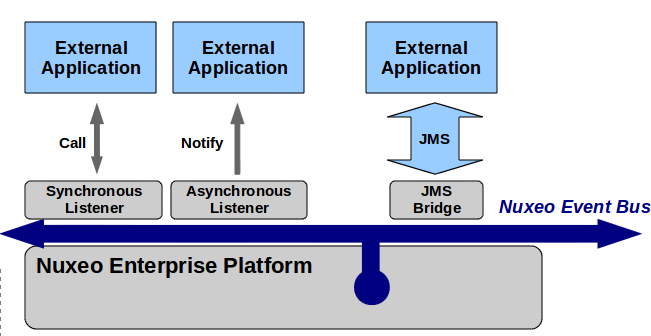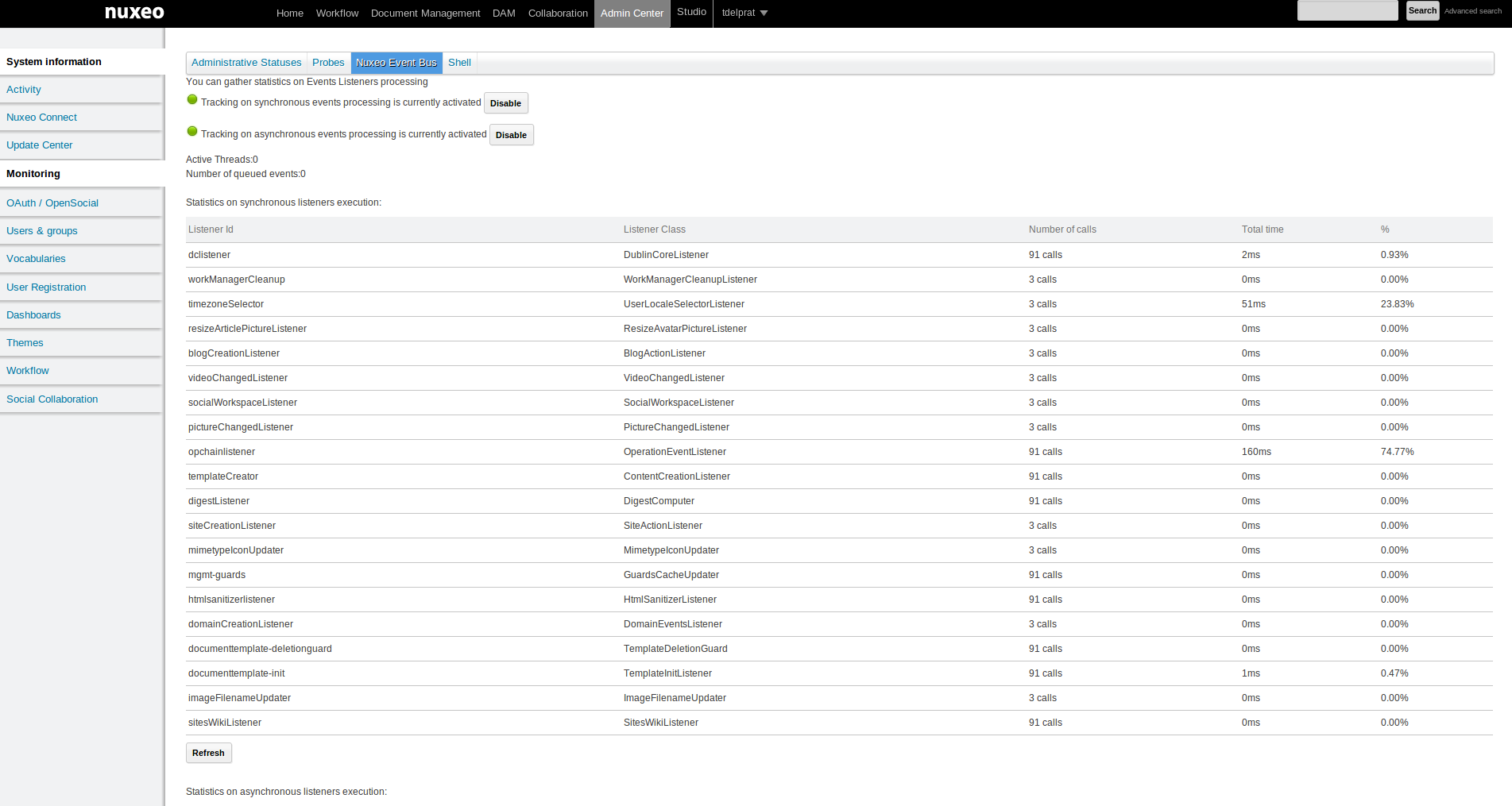When you need to integrate some features of an external application into the Nuxeo Platform, or want the Platform to push data into an external application, using the Nuxeo event system is usually a good solution.
The system allows to contribute event listeners (Java classes) or event handlers (defined in Studio) that subscribe to Platform events such as user login/logout, document creation, document update, document move, workflow started, etc. Those Java classes or automation chains are then executed either synchronously in the transaction, or synchronously out of the transaction, or asynchronously.
The event bus system is a nice way to implement some triggers in the document repository, and to let the repository notify other elements of your IT system of the changes that happen in the repository.


Concepts
A core event has a source which is usually the document model currently being manipulated. It can also store the event identifier, that gives information about the kind of event that is happening, as well as the principal connected when performing the operation, an attached comment, the event category, etc.
Events sent to the event service have to follow the org.nuxeo.ecm.core.event.Event interface.
A core event listener has a name, an order, and may have a set of event identifiers it is supposed to react to. Its definition also contains the operations it has to execute when receiving an interesting event.
Event listeners have to follow the org.nuxeo.ecm.core.event.EventListener interface.
Several event listeners exist by default in the nuxeo platform, for instance:
DublinCoreListener: it listens to document creation/modification events and sets some Dublin Core metadata accordingly (date of creation, date of last modification, document contributors...)DocUIDGeneratorListener: it listens to document creation events and adds an identifier to the document if an UID pattern has been defined for this document type.
Registering an Event Listener
Check Nuxeo CLI to bootstrap your Event Listener.
Event listeners can be registered using extension points. Here are example event listeners registrations from the Nuxeo Platform:
<extension target="org.nuxeo.ecm.core.event.EventServiceComponent" point="listener">
<listener name="dclistener" async="false" postCommit="false" priority="120"
class="org.nuxeo.ecm.platform.dublincore.listener.DublinCoreListener">
<event>documentCreated</event>
<event>beforeDocumentModification</event>
<event>documentPublished</event>
<event>lifecycle_transition_event</event>
<event>documentCreatedByCopy</event>
</listener>
</extension>
<extension target="org.nuxeo.ecm.core.event.EventServiceComponent" point="listener">
<listener name="annotationsVersionEventListener" async="true" postCommit="true"
class="org.nuxeo.ecm.platform.annotations.repository.service.VersionEventListener">
<event>documentCheckedIn</event>
<event>documentRemoved</event>
<event>versionRemoved</event>
<event>documentRestored</event>
</listener>
</extension>
When defining an event listener, you should specify:
- a name, useful to identify the listener and let other components disable/override it,
- whether the listener is synchronous or asynchronous (default is synchronous),
- whether the listener runs post-commit or not (default is false),
- an optional priority among similar listeners,
- the implementation class, that must implement
org.nuxeo.ecm.core.event.EventListenerfor synchronous inline listeners ororg.nuxeo.ecm.core.event.PostCommitEventListenerfor others (post-commit or asynchronous listeners), - an optional list of event ids for which this listener must be called (it is strongly recommended to explicitly list the relevant events, for performance reasons).
There are several kinds of listeners:
- synchronous inline listeners are run immediately in the same transaction and same thread, this is useful for listeners that must modify the state of the application like the beforeDocumentModification event.
- synchronous post-commit listeners are run after the transaction has committed, in a new transaction but in the same thread, this is useful for logging.
- asynchronous listeners are run after the transaction has committed, in a new transaction and a separate thread, this is useful for any long-running operations whose result doesn't have to be seen immediately in the user interface.
Note that in a clustered scenario, asynchronous listeners are not necessarily executed on the same Nuxeo instance as the one on which the event was created, they can be executed on any Nuxeo node (unless a specific configuration for the work queues prevents that).
Processing an Event Using an Event Listener
Here is a simple event listener:
import org.nuxeo.ecm.core.event.Event;
import org.nuxeo.ecm.core.event.EventContext;
import org.nuxeo.ecm.core.event.EventListener;
import org.nuxeo.ecm.core.event.impl.DocumentEventContext;
public class BookEventListener implements EventListener {
public void handleEvent(Event event) {
EventContext ctx = event.getContext();
if (!(ctx instanceof DocumentEventContext)) {
return;
}
DocumentModel doc = ((DocumentEventContext) ctx).getSourceDocument();
if (doc == null) {
return;
}
String type = doc.getType();
if ("Book".equals(type)) {
process(doc);
}
}
public void process(DocumentModel doc) {
...
}
}
Note that if a listener expects to modify the document upon save or creation, it must use events emptyDocumentModelCreated or beforeDocumentModification, and not save the document, as these events are themselves fired during the document save process.
If a listener expects to observe a document after it has been saved to do things on other documents, it can use events documentCreated or documentModified.
Sending an Event
It is not as common as having new listeners, but sometimes it's useful to send new events. To do this you have to create an event context referencing the document, create an event in that context, then send it to the event producer service:
EventProducer eventProducer = Framework.getService(EventProducer.class);
DocumentEventContext ctx = new DocumentEventContext(session, session.getPrincipal(), doc);
ctx.setProperty("myprop", "something");
Event event = ctx.newEvent("myeventid");
eventProducer.fireEvent(event);
You can also have events be sent automatically at regular intervals using the Scheduling Periodic Events, see that section for more information.
Handling Errors
Bubbling Errors
When an event is fired, the Event Service runs every registered listener for this event (ordered by priority - see above). By default, if an error occurs for one listener, it is catched and logged, and the Event Service continues executing the other listeners. In the log, a message is displayed:
Exception during yourListener sync listener execution, continuing to run other listeners
If you throw an error in your listener and want the Event Service to stop execution and push the error to the caller, use the Event#markBubbleException method. In the following example, we have a synchronous event (configured to be triggered only for beforeDocumentModification), and want to be granular and forbid the modification of the dc:rights field if the lifecycle state is "expired":
public class MyDoNotModifyRights implements EventListener {
@Override
public void handleEvent(Event event) {
// . . . see above: Check doc type, check lifecycle state, ...
if(doc.getProperty("dc:rights").isDirty()) {
// = = = = = = = = = = = = = = = = = = = =
// Tell the event the exception must be bubbled
event.markBubbleException();
// = = = = = = = = = = = = = = = = = = = =
throw new NuxeoException("dc:rights cannot be modified for an expired MyDoc");
}
}
}
Now, the error logged states the other listeners will not be run:
Exception during yourListener sync listener execution, other listeners will be ignored
Handling a Listener Error in the UI Layer
Sometimes, you may want to handle errors that occurred in an inline listener in the UI layer. This is a little bit tricky but do-able.
In the listener, you should register the needed information in a place that is shared with the UI layer. You can use the document context map for this.
...
DocumentEventContext ctx = (DocumentEventContext) event.getContext();
DocumentModel doc = ctx.getSourceDocument();
doc.putContextData(MY_ERROR_KEY, "some info");
...
Another thing is to ensure that the current transaction will be rolled back. Marking the event as rollback makes the event service throw a runtime exception when returning from the listener.
...
TransactionHelper.setTransactionRollbackOnly();
event.markRollBack();
throw new NuxeoException("rolling back");
...
Then the error handling in the UI layer can be managed like this
...
DocumentModel doc = ...;
try {
// doc related operations
} catch (NuxeoException e) {
Serializable info = doc.getContextData(MY_ERROR_KEY);
if (info == null) {
throw e;
}
// handle code
}
...
Asynchronous vs Synchronous Listeners
Asynchronous listeners will run as Work instances in a separated WorkManager thread or on a separate Nuxeo instance. This means that the main transaction, the one that raised the event, won't be blocked by the listener processing.
Therefore if the processing done by the listener may take a long time, this is a good candidate for asynchronous processing.
However, there are some impacts in moving a synchronous listener to an asynchronous one:
- The listener signature needs to change: rather than receiving a single event, it will receive an EventBundle that contains all events inside the transaction.
- Because the listener runs in a separate transaction it cannot rollback the source transaction (it is too late anyway).
- The listener code needs to be aware that it may have to deal with new cases; typically, the listener may receive an event about a document that has since been deleted.
Performance and Monitoring
Using listeners, especially synchronous ones, may impact the global performance. Typically, having synchronous listeners that do long processing will reduce the scalability of the system.
In that kind of situation, using an asynchronous listener is the recommended approach:
- The interactive transaction is no longer tied to listener execution.
- The
WorkManagerallows to configure how many asynchronous listeners can run in concurrency.
To monitor execution of the listeners, you can use the Admin Center / Monitoring / Nuxeo Event Bus to
- activate the tracking of listeners execution,
- see how much time is spent in each listener.


For diagnostic and testing purpose, you can use the EventAdminService to activate / deactivate listeners one by one.
The EventServiceAdmin is accessible:
- via Java API
- via JMX